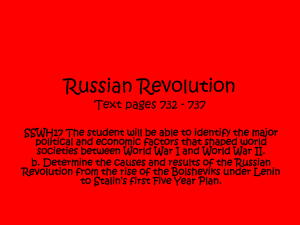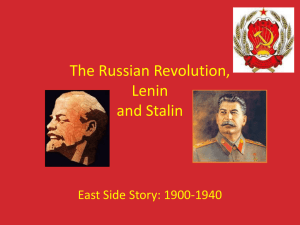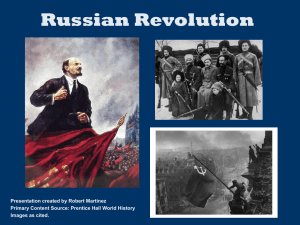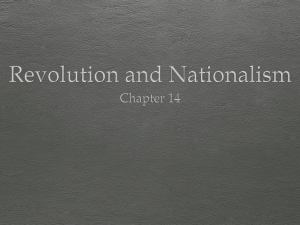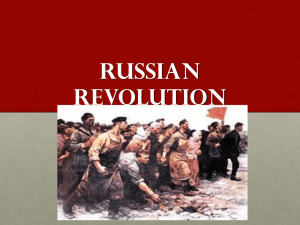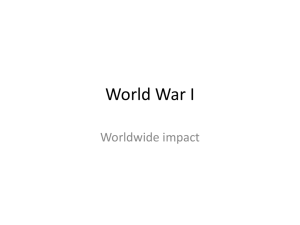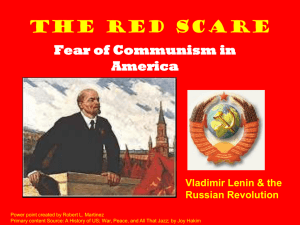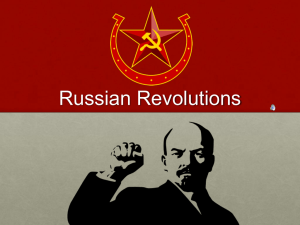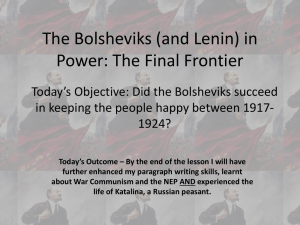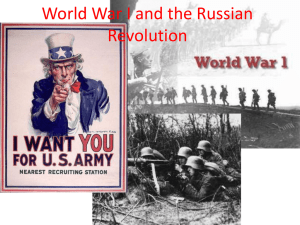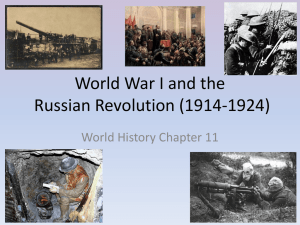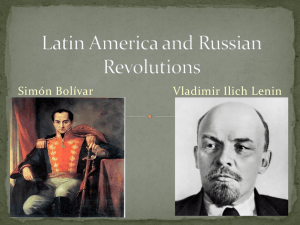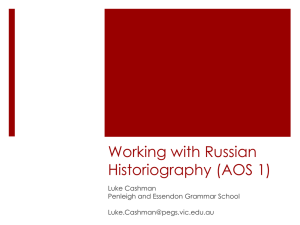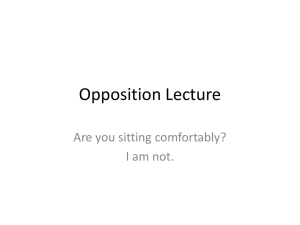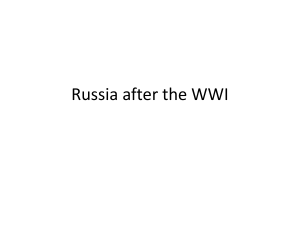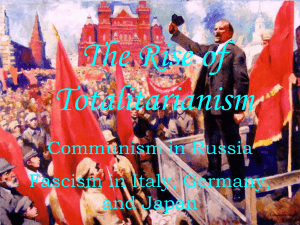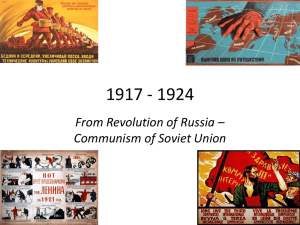Ch14Sec5
advertisement
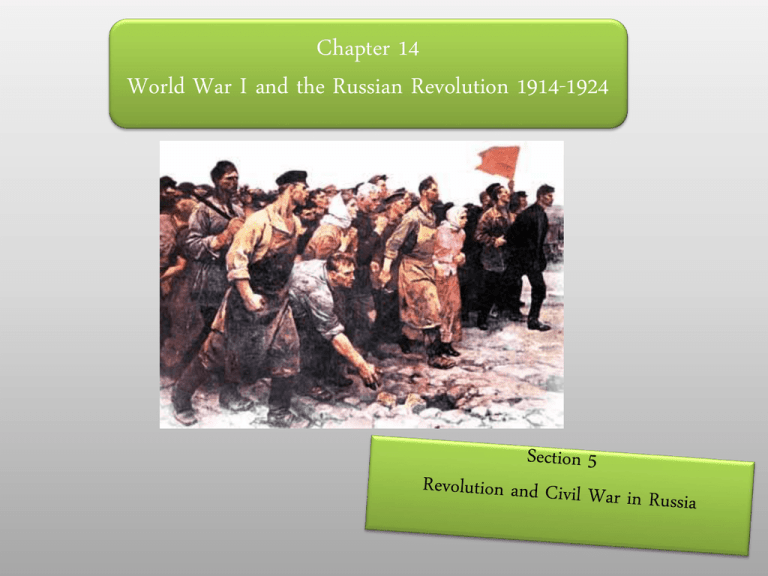
Chapter 14 World War I and the Russian Revolution 1914-1924 Objectives for this section: *Explain the causes of the March Revolution. *Describe the goals of Lenin and the Bolsheviks in the November Revolution. *Outline how the Communists defeated their opponents in Russia’s civil war. *Analyze how the Communist state developed under Lenin. The March Revolution Ends Tsarism In 1914, the huge Russian empire stretched from Eastern Europe to the Pacific Ocean. Unlike Western Europe, Russia was slow to industrialize despite its huge potential. Landowning nobles, priests, and an autocratic tsar controlled the government and economy. Much of the majority peasant population endured stark poverty. As Russia began to industrialize, a small middle class and an urban working class emerged. Unrest Deepens After the Revolution of 1905, Nicholas had failed to solve Russia’s basic political, economic, and social problems. The elected Duma set up after the revolution had no real power. Moderates pressed for a constitution and social change. But Nicholas II, a weak and ineffective leader, blocked attempts to limit his authority. Like past tsars, he relied on his secret police and other forces to impose his will. A corrupt bureaucracy and an overburdened court system added to the government’s problems. Revolutionaries hatched radical plots. Some hoped to lead discontented peasants to overthrow the tsarist regime. Marxists tried to ignite revolution among the proletariat (growing class of factory and railroad workers, miners, and urban wage earners). A revolution, they believed, would occur when the time was ripe. Impact of WWI The outbreak of the war in 1914 fueled national pride and united Russians. Armies dashed to battle with enthusiasm. But like the Crimean war, WWI quickly strained Russian resources. Factories could not turn out enough supplies. The transportation system broke down, delivering only a trickle of crucial materials to the front. By 1915, many soldiers had no rifles and no ammunition. Badly equipped and poorly led, they died in staggering numbers. In 1915 alone, Russian causalities reached two million. Nicholas II decided to take charge of the military and temporarily left his position as tsar of Russia. This decision backfired because the Russian army were no more successful under his command. At the same time, things in Russia suffered even more in his absence. The Tsar Steps Down By March 1917, disasters on the battlefield, combined with food and fuel shortages on the home front, brought the monarchy to collapse. In St. Petersburg workers were going on strike. People marched through the streets and troops refused to fire on the demonstrators leaving the government helpless. Finally, on the advice of military and political leaders, the tsar abdicated. Duma politicians then set up a provisional, or temporary, government. Middle-class liberals in the government began preparing a constitution for a new Russian republic. At the same time, they continued the war against Germany. Outside the government, revolutionary socialists plotted their own course. In some cities these revolutionaries set up soviets (councils of workers and soldiers). At first, the soviets worked within the government, but before long the Bolsheviks (radical socialist group) took charge. The leader of the Bolsheviks was Vladimir Lenin. Lenin and the Bolsheviks Vladimir Lenin *Vladimir was born in 1870 to a middle-class family. He changed his last name to Lenin when he became a revolutionary. *When he was 17 his older brother was arrested and hanged for plotting to kill the tsar. The execution branded his family as a threat to the state and made the young Vladimir hate the tsarist government. A Brilliant Revolutionary As a young man, Lenin read the works of Karl Marx and participated in student demonstrations He spread Marxist ideas among factory workers. In 1895 Lenin was arrested and sent to Siberia. After his sentence was served he was exiled to Switzerland. He worked tirelessly to spread revolutionary ideas. Lenin’s View of Marx Lenin adapted Marxist ideas to fit Russian conditions. Marx had predicted that the industrial working class would rise spontaneously to overthrow capitalism. But Russia did not have a large urban working class. Instead, Lenin called for an elite group to lead the revolution and set up a dictatorship of the working class. Lenin named this group the Bolsheviks meaning “majority”. In Western Europe, many leading socialists had come to think that socialism could be achieved through gradual and moderate reforms such as higher wages, increased suffrage, and social welfare programs. A group of socialists in Russia, the Mensheviks, favored this approach. The Bolsheviks rejected it. To Lenin, reforms of this nature were merely capitalists tricks. He believed that only revolution could bring about needed changes. In March 1917, Lenin was still in exile. As Russia stumbled into revolution, Germany saw a chance to weaken its enemy by helping Lenin return home. Lenin rushed across Germany to the Russian frontier in a special train. He greeted a crowd of fellow exiles and rallied them into action against the Russian government. The November Revolution Brings the Bolsheviks to Power Lenin threw himself into the work of furthering the revolution. To the hungry, war-weary Russian people, Lenin and the Bolsheviks promised peace, land, and bread. The Provisional Government’s Mistakes The provisional government, led by Alexander Kerensky, continued the war effort and failed to deal with the issues in Russia. This proved to be fatal. Most Russians were tired of war. Troops at the front were deserting. Peasants wanted land, while city workers demanded an end to the desperate shortages. In July 1917, the government launched the disastrous Kerensky offensive against Germany. By November the army was falling apart. Growing numbers of troops mutinied. Peasants seized land and drove off fearful landlords. The Bolshevik Takeover Conditions were ripe for the Bolsheviks to make their move. In November 1917, squads of Red Guards (armed factory workers) attacked the provisional government. In just a matter of days, Lenin’s forces overthrew the provisional government without a struggle. The Bolsheviks quickly seized power in other cities. IN Moscow, it took a week of fighting to blast the local government. Moscow became the Bolsheviks’ capital. The Bolsheviks ended private ownership of land and distributed land to peasants. Workers were given control of the factories and mines. A new red flag with an entwined hammer and sickle symbolized union between workers and peasants. The Bolsheviks soon became the new rulers of Russia. Russia Plunges Into Civil War After the Bolshevik Revolution, Lenin quickly sought out peace with Germany. Russia signed the Treat of Brest-Litovsk in March 1918, giving up a huge chunk of its territory and its population. The cost of peace was extremely high, but the Russians had so many issues at home that they were willing to do whatever it took to fix their nation. Opposing Forces- For three years, civil war raged between the “Reds” (communists/Bolsheviks) and the “Whites” (made up of the tsarists army). War Under Communism- The Communists used terror not only against the Whites, but also to control there own people. They organized the Cheka (secret police force much like the tsar’s). The Cheka executed ordinary citizens, even if they were only suspected of taking action against the revolution. The communists adopted a policy known as “war communism”. They took over banks, mines, factories, and railroads. Peasants in the countryside were forced to deliver almost all of their crops to feed the army and hungry people in the cities. Peasant laborers were drafted into the military or forced to work in factories. The Red army positioned itself in the center of Russia. This gave them a strategic advantage. The White armies were forced to attack separately from all sides. The Whites were not able to coordinate their attacks. By 1921, the Communists had managed to defeat the White army. Building the Communists Soviet Union Russia was in chaos. Millions of people had died since the beginning of World War I. Millions more perished from famine and disease. Lenin faced the enormous problem of rebuilding a shattered state and economy. New Government, Same Problems- In 1922 Lenin’s Communists government reigned supreme. Just as the Russian tsars had, the party used the army and secret police to enforce its will. Russia, which was the largest republic, dominated the other republics. Lenin’s New Economic Policy- Under party control, factory and mine output had fallen. Peasants stopped producing grain, knowing the government would only seize it. In 1921, Lenin adopted the New Economic Policy (NEP). It allowed some private ownership. Under the NEP, peasants hold on to small plots of land and freely sold their surplus crops. This policy helped the Soviet economy recover and improved the quality of life for the people. Stalin Takes Over- Lenin died in 1924 at the age of 54. His death set off a power struggle among Communist leaders. Trotsky: *Brilliant Marxist thinker *One of the leaders of the Bolshevik Revolution *Supported world-wide revolution against capitalism Joseph Stalin: *Political leader *Wanted to focus on building socialism in Russia Trotsky and Stalin saw the future of Russia in different ways. Stalin isolated Trotsky and stripped him of his power for criticizing his policies. In 1940, a friend of Joseph Stalin murdered Trotsky. Stalin became the new leader of Russia and would soon use ruthless measure to gain total control of the country.

